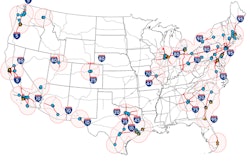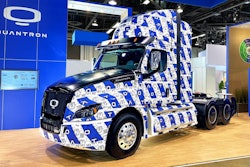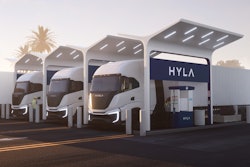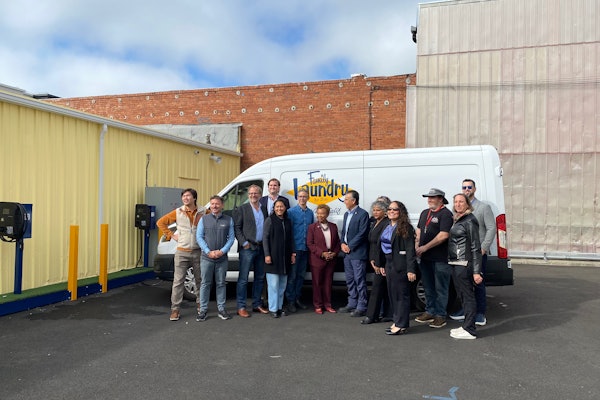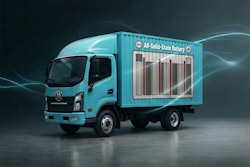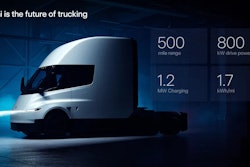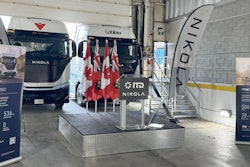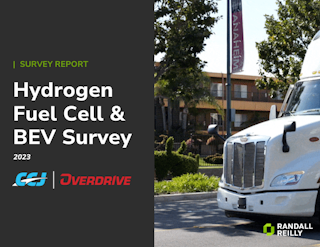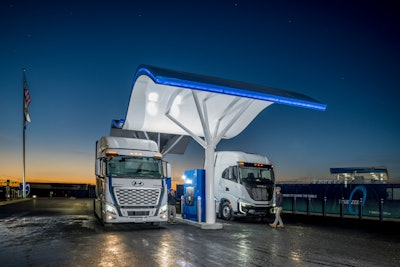
When the commercial hydrogen fueling infrastructure develops for Class 8 commercial trucks, California’s Port of Oakland may be the epicenter from which the buildout eventually emanates.
FirstElement Fuel, the largest hydrogen refueling provider in California with 80-percent market share and 41 True Zero-branded light-duty hydrogen stations in operation, is opening the first ever commercial heavy-duty hydrogen refueling station outside the Port of Oakland. The new station has two heavy-duty pumps capable of supporting 200 trucks per day at a rate of just 10 minutes per 80-kg fill. The station also has four light- and medium-duty pumps onsite to serve as another location for California’s estimated 16,000-vehicle passenger car market.
FirstElement Fuel’s Port of Oakland station uses a cryopump to convert liquid hydrogen into cold, compressed hydrogen in a single stage. The company is partnering with Bosch Rexroth to retrofit the station with Bosch’s next-generation cryopump capable of dispensing 100 kg in 10 minutes.
The new station is part of a state-funded NorCal Zero project developed in conjunction with Hyundai Motor Company and the Center for Transportation and the Environment. The project is funded by the California Energy Commission and the California Air Resources Board.
 FIrstElement Fuels' heavy-duty hydrogen dispensers are capable of fueling a Class 8 hydrogen fuel cell tractor in 10 minutes.
FIrstElement Fuels' heavy-duty hydrogen dispensers are capable of fueling a Class 8 hydrogen fuel cell tractor in 10 minutes.
Liquid hydrogen provides several advantages over gaseous hydrogen. Delivery of gaseous hydrogen to a refueling station results in a roughly 50-percent efficiency loss as the pressurized gas in the delivery tanker reaches equilibrium with the onsite storage tank. “We found that even for these small stations that filled about 40 cars a day, we sometimes had to do two or even three deliveries to meet the needs of the customer demand,” said Stephens. “We quickly saw that this was a system that couldn't scale and couldn't be viable.”
Liquid hydrogen is about 10 times denser than gaseous hydrogen, and nearly all of it can be offloaded from the tanker trailer into the onsite storage tower. “It also means that you can hold a much larger volume in a much smaller footprint when you're storing liquid hydrogen,” added Stephens.
Truck OEMs fueling demand
Hyundai is providing 30 Hyundai Xcient Class 8 tractors for the project, making it the largest deployment of Class 8 hydrogen-powered vehicles in the United States. The trucks will be operated by Glovis America and Global Expedited Transportation Freight for intermodal container hauler operations in the Port of Oakland. In addition to its partnership with Hyundai, FirstElement Fuels has also entered into a 10-year agreement with Nikola to refuel Nikola Tre hydrogen trucks in the Port of Oakland area. Nikola recently opened its first proprietary Hyla hydrogen station in Ontario, Calif., dedicated to Nikola Tre customers. The company plans to open 14 Hyla refueling stations by the end of 2024.
 Hyundai Motor Company is providing 30 Hyundai Xcient fuel cell tractors to the NorCal Zero project in the Port of Oakland.
Hyundai Motor Company is providing 30 Hyundai Xcient fuel cell tractors to the NorCal Zero project in the Port of Oakland.
Jerome Gregeois, director of commercial vehicle development at the Hyundai America Technical Center, said fuel cell tractors hold several advantages over similarly spec’d battery electric vehicles. At 500 miles of range, a fuel cell vehicle has an available payload of 52,000 pounds. A battery-electric vehicle with similar range requires an additional 9,000 pounds of powertrain weight, resulting in just a 43,000-pound payload capacity.
“We're not here to move the truck, we're going to move the goods in the trailers,” said Gregeois. At a theoretical thousand-mile range, “the cost of moving goods [with a battery-electric vehicle] is almost double compared to hydrogen.”
The initial adoption of hydrogen fuel cell commercial vehicles will come from port operations where duty cycles and dedicated runs allow for fewer refueling stations to start. “The ports are one of the really heaviest polluters to a local community with the thousands of trucks that enter here daily,” said Eugene Litvinov, director of commercial vehicle and hydrogen business development for Hyundai Motor North America. “Many of those trucks on their third, fourth and maybe even fifth lifecycle, meaning that they're older models and much more heavily polluting and they're having to idle a lot as they wait for their loads. Over the course of this project, which should be six years, we should be able to eliminate almost 50 million pounds of CO2. We should be able to replace almost 2 million gallons of diesel from being used and something close to 300,000 pounds of other pollutants such as NOx and particular matter. And this is only from 30 trucks operating here. Now magnify all of that by a thousand trucks and see what we can do for the Bay Area and the air quality here.”
State regulators and program managers are optimistic about hydrogen’s role in commercial vehicle applications. If the trucking industry is to see widespread adoption of hydrogen technology, it will require thousands of hydrogen refueling stations in the next 10 years.
“There are use cases and markets for both hydrogen and battery electric vehicles and I think it's important that we support both of them,” said Liane Randolph, chairwoman of the California Air Resources Board. “It is great to have the partnership of the federal government, the hydrogen funding that California received, and the suite of incentives and tax credits that are now available to build that decarbonized economy.”
“We really are on the cusp of commercializing [hydrogen] technology,” said Jaimie Levin, senior program manager and director of the West Coast Office at the Center for Transportation and the Environment. “Our organization is really on a mission to transform the entire transportation sector to zero – that means both battery electric and fuel cell electric. But in the heavy-duty sector there are distinct advantages to fuel cell… including the ability to refuel quickly and the ability to respond and be resilient in natural disasters."

